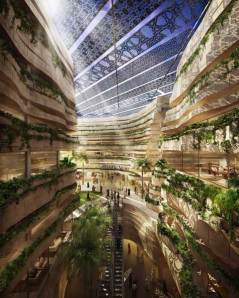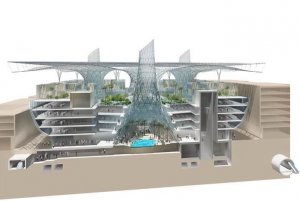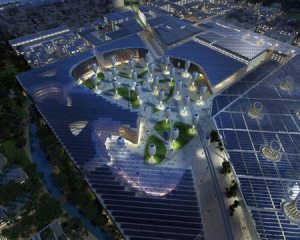Residents have begun to move into Masdar City, the “world’s first carbon-free city” situated in the desert near Abu Dhabi’s international airport. The 2.3 square mile city, designed by British Architects Foster + Partners, will be able to house up to 50,000 people and ultimately will cost the United Arab Emirates about $22 billion. It will be home to a research industry focused on sustainability and renewable energy and eventually various clean-technolgoy companies, along with city residents and will be brimming with energy saving architecture.
The futuristic city is a perfect case study in overlapping systems and fervent sustainability. A network of roadways for electric cars- all traditional cars will be stopped at the walls to the city- runs hidden below the city. Masdar City’s ground level was elevated 23 feet to allow room for the automated system of electric vehicles to operate underneath. The streets above will be kept clean and pedestrian friendly.
There are an incredible amount of systems at work in Masdar City, just as in any city, but architects have taken special care to integrate man-made systems with the natural environment. Streets are laid out in harmony with the sun and wind cycles, situated to catch the most shade and cross-breezes in the hot desert. Harmful systems, like that of traditional transportation found in every other city, are kept out and systems are re-engineered to be kinder to the environment. Narrow pedestrian streets will catch some sunlight from the majority of the desert’s harsh, hot rays by building overhangs.
Wind tunnels will funnel air downwards, cooled by water sprays along the way, to ventilate public squares at the base. The walls at the edge of the city will not only keep out cars and noise from the nearby airport, but also block hot desert winds.
“Water will flow from a solar-powered seawater-desalinization plant. Produce will come from nearby greenhouses, and all waste will be composted or otherwise recycled.” (New York Times).
“60% of the water demand will be provided by recycled water which will be cleaned and be safe enough for drinking, irrigation and any other potable use. All of the waste in Masdar City will be managed through an integrated, user-friendly, invisible and odorless system.” -SincerelySustainable.com
Masdar City seems almost too good to be true, but residents are already moving in and making the green dream a reality. Although the city has its critics for being a futuristic, sustainable Disneyland incapable of achieving the vibrance and life of a true city, it is a huge step in the right direction for sustainability. Masdar City incorporates an incredible amount of green technology and systems; while every city cannot start from scratch with an extensive web of sustainable systems, they can certainly learn some lessons from Masdar. If one city can incorporate so much, cities across the globe can at least adopt parts.






This seems like a very cool idea and a great study to see where planning on the city scale can go. I do wonder why there is so much innovative architecture in such a harsh environment though and if this is worth the effort needed. The middle east has little water resources and the irrigation needed to grow plants in a city is considerable. The money funding such a process comes from selling oil and promoting consumption of fossil fuels. The transportation cost of getting materials and contractors to Abu Dhabi is also something to consider. There are great things being explored in Dubai, Abu Dhabi, and the middle east but I feel like these would be much more beneficial if there were done in more practical, temperate climates.